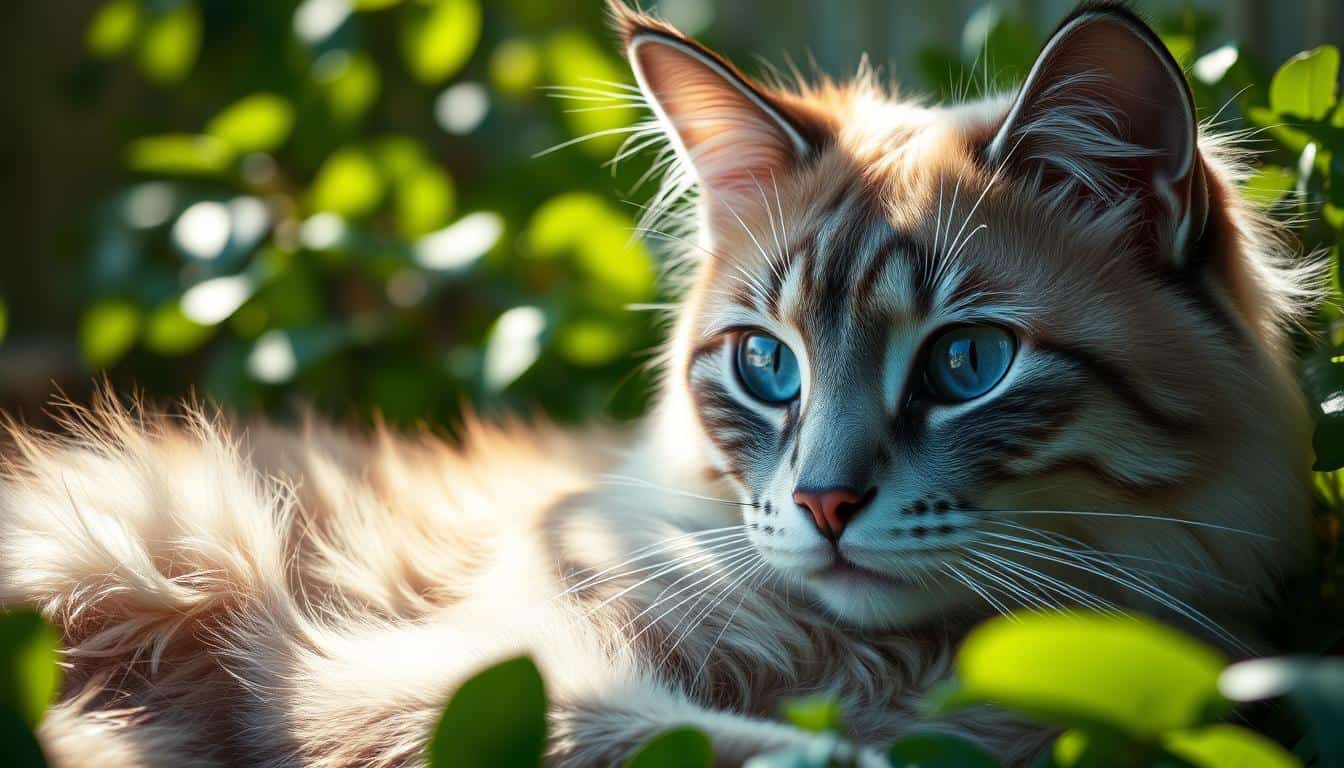Introduction
I’ve always been drawn to the magical gaze of blue-eyed cats. Their eyes seem to hold a secret, a window to a world of wonder. If you love these cats as much as I do, this guide is for you. It will explore their genetics, popular breeds, and how to care for them.
sBlue-eyed cats, like the Siamese and Ragdoll, have a special charm. Their eye color is more than just a look; it shows the complex genetics of cats. This guide will explain their eye color and how to care for your blue-eyed cat.
This guide is for anyone who loves cats or is fascinated by their blue eyes. It’s your key to understanding these amazing animals. Get ready to learn, be inspired, and discover the magic of blue-eyed cats.
- Understanding Blue Eyes in Cats: A Genetic Marvel
- Popular Cat Breeds With Blue Eyes
- The Connection Between White Fur and Blue Eyes
- Siamese and Colorpoint Cats: The Blue-Eyed Beauties
- How to Care for a Cat with Blue Eyes
- Common Health Issues in Blue-Eyed Cats
- Myths and Facts About Cats With Blue Eyes
- Photographing Your Blue-Eyed Feline
- Special Considerations When Adopting a Blue-Eyed Cat
- FAQ:
Understanding Blue Eyes in Cats: A Genetic Marvel
Blue eyes in cats have always amazed cat lovers. But what makes them so special? Let’s explore the world of cat genebtics and feline ocular traits to learn about their stunning blue color.
The Science Behind Feline Eye Pigmentation
A cat’s eye color comes from a pigment called melanin. Melanin creates shades from brown to the mesmerizing blue we love.
Melanin’s Role in Eye Color Development
In cats with blue eyes, there’s less melanin in the iris. This lack of pigment lets light through, making the eyes appear blue. The cat eye pigmentation is a fine balance. Any change in melanin can result in different eye colors.
Genetic Inheritance Patterns
- The blue eye color in cats comes from a specific gene mutation that affects melanin production.
- This mutation is recessive, so both parents must carry the gene for a kitten to have blue eyes.
- Cats with two recessive genes will have blue eyes. Those with one recessive and one normal gene can have green, amber, or hazel eyes.
Exploring cat genetics behind eye color is fascinating. It shows the amazing diversity of our feline friends. By understanding this science, we can truly appreciate the beauty of blue-eyed cats.
Popular Cat Breeds With Blue Eyes
Blue-eyed cats are truly captivating. They come from many purebred cat breeds. These include the elegant Siamese and the playful Ragdoll. Each breed shows the amazing variety of feline eye colors.
The Siamese is well-known for its blue eyes. They have striking color points and a darker mask, ears, legs, and tail. Their pale body and sapphire eyes make them look regal.
Ragdolls are also famous for their blue eyes. These cats have soft, silky coats and loving personalities. Their eyes can be deep cobalt or icy azure, making each one unique.
The Russian Blue has stunning blue eyes too. They have a shiny silver-blue coat and emerald-green eyes. Their blue eyes come from their special genetics.
| Breed | Eye Color | Temperament |
|---|---|---|
| Siamese | Sapphire blue | Intelligent, vocal, and affectionate |
| Ragdoll | Icy blue to deep cobalt | Gentle, calm, and social |
| Russian Blue | Emerald green to icy blue | Reserved, intelligent, and loyal |
These breeds have won the hearts of many cat lovers. Whether you prefer the Siamese’s elegance or the Ragdoll’s gentleness, they add magic to any home.
The Connection Between White Fur and Blue Eyes
In the world of cat genetics, the link between white fur and blue eyes is fascinating. Scientists and cat lovers alike are curious about the genetic factors behind this unique feature.
Understanding the White Masking Gene
The white fur in cats is often tied to the white masking gene. This gene can change a cat’s eye color. It makes the white coat stand out and can also cause blue eyes in some cats.
Deafness in White Cats With Blue Eyes
White cats with blue eyes might have a higher risk of deafness. The genes that cause their white coat and blue eyes can also affect their hearing. This is something to think about for cat owners, as these cats might need special care.
Health Considerations for White Blue-Eyed Cats
White cats with blue eyes might also face other health issues. They can be more sensitive to sunlight, which can cause skin problems or even skin cancer. Owners need to watch their cat’s health closely to keep them happy and healthy.
“The striking combination of white fur and blue eyes in cats is a testament to the remarkable diversity of feline genetics.”
Siamese and Colorpoint Cats: The Blue-Eyed Beauties
Siamese and colorpoint cats are among the most stunning blue-eyed cat breeds. They are known for their striking blue eyes and unique coat patterns. These traits make them a favorite among cat lovers worldwide.
Siamese cats have a rich history, originating from Thailand (formerly Siam). They are famous for their “pointed” coat, with darker colors on their face, ears, legs, and tail. Their lighter body color and blue eyes make them stand out. Siamese cats are known for being affectionate and vocal, making great companions.
Closely related to Siamese cats, colorpoint cats also have the same blue-eyed, pointed coat pattern. They come in various colors like seal, chocolate, lilac, and red. Colorpoint cats are known for their loyalty and intelligence, forming strong bonds with their families.
| Breed | Eye Color | Coat Color | Temperament |
|---|---|---|---|
| Siamese | Blue | Pointed pattern | Affectionate, vocal |
| Colorpoint | Blue | Pointed pattern in various colors | Loyal, intelligent |
The blue eyes of Siamese and colorpoint cats come from a genetic trait. This trait stops the production of melanin, the pigment that gives eyes color. Their unique eyes and coat patterns make them highly sought after by cat lovers.

“The Siamese cat is a paradox in the cat fancy world. They are both loved and loathed, adored and despised, and yet they remain one of the most popular breeds of cats.”
If you’re interested in blue-eyed cats, Siamese and colorpoint cats are perfect. They will captivate your heart and leave an impression that will last forever. Explore the world of Siamese and colorpoint cats and their charm.
How to Care for a Cat with Blue Eyes
As the owners of cats with blue eyes, it’s key to know their special needs. This guide will help you keep your cat healthy and happy. It covers eye health checkups and creating a good environment.
Regular Eye Health Checkups
Blue-eyed cats need regular vet visits because they can get eye problems. Your vet can check their eyes for irritation or inflammation. Catching issues early helps keep their vision sharp.
Environmental Considerations
- Make sure they have shade and protection from the sun, as they’re sensitive to glare and UV.
- Keep their environment clean and dust-free to avoid irritation.
- Use humidifiers to keep the air moist, as dry air can make eye problems worse.
Diet and Nutrition Impact
A good diet is crucial for your blue-eyed cat’s health. Talk to your vet about the right food and supplements for their eye health.
“Proper care and attention to your blue-eyed cat’s needs can help ensure a long, happy, and healthy life.”
By following these tips, you can give your blue-eyed cat the best care. Regular vet visits, a good environment, and a balanced diet are key. They help keep your cat’s cat eye characteristics and feline eye color in great shape.
Common Health Issues in Blue-Eyed Cats
Blue-eyed cats are a sight to behold, but they face some health challenges. It’s important for owners to know about these issues. This way, they are able to give their pet the best quality of.
Blue-eyed cats are more sensitive to light. Their lack of iris pigmentation makes them uncomfortable in bright places. It’s key to check their eyes often and adjust their environment to keep them comfortable.
These cats are also more likely to get eye problems like congenital ocular defects and photophobia. These can range from minor to serious. Watching for any eye issues and acting fast is crucial.
| Common Health Issues in Blue-Eyed Cats | Symptoms | Treatment |
|---|---|---|
| Sensitivity to Light | Squinting, Frequent Blinking, Avoidance of Bright Environments | Providing Shaded Areas, Limiting Exposure to Bright Light |
| Congenital Ocular Defects | Abnormal Eye Shape, Vision Impairment, Inflammation | Veterinary Examination, Medications, Specialized Care |
| Photophobia | Discomfort in Bright Light, Squinting, Excessive Tearing | Adjusting Lighting, Prescription Eye Drops, Sunglasses |
Knowing about these health issues helps keep your blue-eyed cat happy and healthy. Regular vet visits and watching their eyes are key. This ensures these special cats live a long, comfortable life.

Myths and Facts About Cats With Blue Eyes
There are many myths about cats with blue eyes. Let’s look at the facts and clear up the misconceptions.
Debunking Common Misconceptions
One myth is that all white cats with blue eyes are deaf. While many white cats with blue eyes may have hearing loss, not all do. The link between white fur, blue eyes, and deafness comes from genetics, but it’s not a rule for all.
Another myth is that blue-eyed cats are more delicate or have more health problems. But, a cat’s eye color doesn’t affect its health. Blue-eyed cats are just as healthy and strong as cats with other eye colors, if they’re well cared for.
Scientific Evidence and Research
Research has shown why some cats have blue eyes. It’s because they lack melanin in their iris. This genetic condition, known as cat genetics, affects their feline eye color and can be passed down.
Studies found that blue eyes are more common in certain breeds like Siamese and Ragdoll cats. These breeds have genes that make their eyes blue, which is a key part of their breed identity.
“While blue eyes in cats may appear striking and unique, they do not define the overall health or temperament of the animal.”
It’s key to know that myths about cat with blue eyes aren’t based on science. By understanding the genetics and research, we can see these cats for the amazing pets they are.
Photographing Your Blue-Eyed Feline
Capturing your cat’s stunning blue eyes is a fun challenge for any photographer. Whether you’re experienced or new, these tips will help you highlight your cat’s eye patterns and vibrant color. This makes your cat with blue eyes truly captivating.
Lighting is Key
Good lighting is crucial for showing off your cat’s eye features. Look for soft, diffused light that doesn’t create harsh shadows or bright spots. Natural light near a window is great, or use a reflector to add more light.
Composition and Angles
Get close to your cat’s eyes. Try different angles, like shooting from below or slightly above, to show their gaze’s depth and intensity. Make sure your cat feels relaxed and comfortable during the photoshoot.
Camera Settings for Cat Eye Patterns
Adjust your camera to focus on your cat’s eyes. Use a shallow depth of field to make the eyes sharp while blurring the background. Also, increase your ISO to get a fast shutter speed. This will help freeze your cat’s movements and avoid blurry photos.
Patience and Treats
Photographing cats can test your patience, but with persistence and treats, you’ll get the shots you want. Keep your sessions short and positive. Celebrate your successes along the way.
By following these tips, you’ll be on your way to taking stunning photos of your blue-eyed feline. Enjoy the challenge and the process of capturing your cat’s captivating gaze.
Special Considerations When Adopting a Blue-Eyed Cat
Adopting a blue-eyed cat is a joy, but it needs extra care. Make sure you know the health checks and adoption steps. This will help your new pet settle in smoothly.
Health Screening Requirements
Good breeders and shelters focus on the health of blue-eyed cats. They do detailed health checks. Ask about genetic tests, vision checks, and medical history.
This info helps you decide and prepare for health issues.
Adoption Process Tips
The adoption process for blue-eyed cats takes more time. Be patient and thorough. You’ll need to talk about your home, past pets, and care plans.
A trusted group wants to make sure the cat goes to a loving home. They check if your home meets the cat’s special needs.
FAQ:
What breed of cat has blue eyes?
Siamese, Ragdoll, and Russian Blue are popular for their blue eyes. These breeds have been bred to show off their eye color. Their unique genes and coat patterns make it happen.
Do blue-eyed cats have vision problems?
Generally, cats with blue eyes do not experience vision problems solely due to their eye color. However, some breeds, such as the Siamese, may have a higher likelihood of congenital conditions like strabismus, which can affect vision. It’s essential to ensure regular veterinary check-ups to monitor overall eye health.
Are all blue-eyed cats Siamese?
Not all cats with blue eyes are Siamese. While blue eyes are a signature trait of the Siamese breed, other breeds like the Ragdoll and the Birman can also have blue-eyed cats. Blue eyes can also be found in some mixed-breed cats, though it’s often more common in specific pedigreed breeds.
What causes blue eyes in cats?
Blue eyes in cats come from a lack of pigment in the iris. This is often due to a genetic mutation. It leads to less melanin, the pigment that gives eyes color. Breeds like Siamese and Ragdoll often have blue eyes because of their genes.
Are all white cats with blue eyes deaf?
Not all white cats with blue eyes are deaf. But, they might be more likely to be deaf. This is because their white coat and blue eyes are linked to a gene that can affect their ears. It’s smart to have regular vet visits and hearing tests for these cats.
Can cats with blue eyes develop any health problems?
Blue-eyed cats are usually healthy. But, they might be more likely to have eye problems like light sensitivity. They could also have corneal ulcers or deafness. Regular vet visits are key to catching and treating these issues early.
How can I take great photos of my blue-eyed cat?
Taking amazing photos of your blue-eyed cat needs some tips. Use natural or soft light to avoid shadows. Try different angles and compositions to focus on the eyes. Avoid direct flash for reflections. Use a macro lens or get close to capture the details. With practice, you can capture your cat’s blue eyes beautifully.
Share your thoughts in the comments below! If you enjoyed this post, consider subscribing to our newsletter for more pet tips, stories and blogs!

